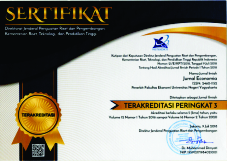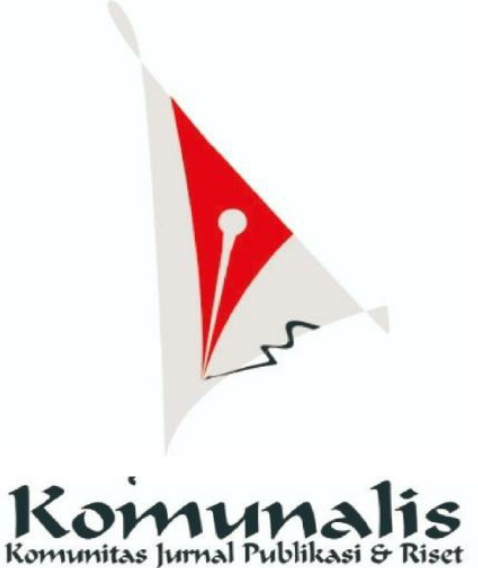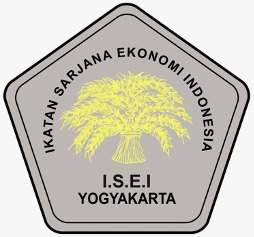The Nexus Between Financial Stability and Economic Growth in Southeast Asia
Downloads
Abstract
Financial stability is an important part of economic growth. The main objective of this study is to analyse how financial stability (using Bank Z-Score) affects economic growth. The data used is country-level data from five selected Southeast Asian countries (Indonesia, Cambodia, Malaysia, Philippines, and Thailand) for the period 2011 – 2021 using the ARDL model approach. The results of this study found strong evidence that financial stability (banking stability) has a positive effect on economic growth for countries in the Southeast Asian region. This study also reveals that it is not only important financial stability variables to achieve economic growth, but investment and trade openness must also be increased if the country is to achieve its expected economic growth. A positive correlation between investment and trade openness suggests a potential for these factors to contribute to economic growth synergistically.
Keywords:Financial Stability, Economic Growth, Bank Z-Score, ARDL
Downloads
Agung, A., Agung, K., Putra, D., & Oktora, S. I. (2023). The Effect Of Financial Inclusion And Economic Integration On Green Growth in ASEAN. https://doi.org/10.1108/JED-09-2023-0169
Ahulu, H., MacCarthy, J., & Muda, P. (2021). Financial Stability and Economic Growth Nexus: Evidence From Sub-Saharan Africa Using Panel Data. International Journal of Economics and Financial Issues, 11(4), 11–18. https://doi.org/10.32479/ijefi.11407
Akalpler, E. (2021). Financial Stability and Economic Growth: Evidence from North Cyprus. SSRN Electronic Journal. https://doi.org/10.2139/ssrn.3973808
Akinbode, S. O., Dipeolu, A. O., Bolarinwa, T. M., & Olukowi, O. B. (2021). Effect Of Health Outcome On Economic Growth In Sub-Saharan Africa: A System Generalized Method Of Moment Approach. Journal of Economics and Development, 23(3), 254–266. https://doi.org/10.1108/jed-06-2020-0078
Alsamara, M., Mrabet, Z., Jarallah, S., & Barkat, K. (2019). The Switching Impact Of Financial Stability And Economic Growth In Qatar: Evidence From An Oil-Rich Country. The Quarterly Review of Economics and Finance, 73, 205–216. https://doi.org/10.1016/J.QREF.2018.05.008
Amali, E., Igwe, G. U., & Oballum, C. E. (2022). Impact of Financial Stability on Economic Growth: Evidence From Nigeria. American International Journal of Economics and Finance Research, 5(1), 1–12. https://doi.org/10.46545/aijefr.v5i1.245
Apostolakis, G., & Papadopoulos, A. P. (2019). Financial Stability, Monetary Stability and Growth: a PVAR Analysis. Open Economies Review, 30(1), 157–178. https://doi.org/10.1007/s11079-018-9507-y
Barra, C., & Zotti, R. (2022). Financial Stability And Local Economic Development: The Experience Of Italian Labour Market Areas. Empirical Economics, 62(4), 1951–1979. https://doi.org/10.1007/s00181-021-02071-x
Barro, R. J., & Sala-i-Martin, X. (2003). Economic Growth (2nd ed.). MIT Press Books.
Dhal, S., Kumar, P., & Ansari, J. (2011). Financial Stability, Economic Growth, Inflation and Monetary Policy linkages in India: An Empirical Reflection. Reserve Bank of India Occasional Papers, 32(3).
Emara, N., Professor, A., Zhang, X., & Liu, S. (2019). Economic Growth and Financial Stability in MENA Countries: Does Exporting Oil Matters?. Munich Personal RePEc Archive. 99312. https://ideas.repec.org/p/pra/mprapa/99312.html
Ijaz, S., Hassan, A., Tarazi, A., & Fraz, A. (2020). Linking bank competition, financial stability, and economic growth. Journal of Business Economics and Management, 21(1), 200–221. https://doi.org/10.3846/jbem.2020.11761
Islam, M. S., & Mustafa Shindaini, A. J. (2022). Impact Of Institutional Quality And Human Capital Creation On Economic Growth In Bangladesh: Evidence From An ARDL Approach. International Journal of Social Economics, 49(12), 1787–1802. https://doi.org/10.1108/IJSE-12-2021-0732
Isreal Akingba, I. O., Kaliappan, S. R., & Hamzah, H. Z. (2018). Impact Of Health Capital On Economic Growth In Singapore: An ARDL Approach To Cointegration. International Journal of Social Economics, 45(2), 340–356. https://doi.org/10.1108/IJSE-12-2016-0376
Kabir, S., Bloch, H., & Salim, R. A. (2018). Global Financial Crisis And Southeast Asian Trade Performance: Empirical Evidence. Review of Urban and Regional Development Studies, 30(2). https://doi.org/10.1111/rurd.12080
Kenedi, K. (2022). Pengaruh Konsumsi Energi dan Pajak Dengan Mediasi Pertumbuhan Ekonomi Terhadap Polusi di 9 Negara ASEAN. Jurnal Bina Bangsa Ekonomika, 15(1), 201–210. https://doi.org/10.46306/jbbe.v15i1.156
Kenedi, K., & Sukmawan, I. (2022). Dampak Health Capital Terhadap Pertumbuhan Ekonomi: Pembuktian Dari Negara Terpilih di Asia Tenggara Dengan Pendekatan Model Autoregressive Distributed Lag (ARDL). National Conference on Applied Business, Education, & Technology (NCABET), 2(1), 135–148. https://doi.org/10.46306/ncabet.v2i1.73
Khan, A. B., Siriphan, T., Mookda, R., Kongnun, T., Rattanapong, S., Omanee, Y., & Thonghom, P. (2021). Impact Of Global Financial Crisis 2008-09 And Global Oil Prices On The Economic Growth Of Asean Countries: An Evidence From Driscoll-Kraay Standard Errors Regression. Academy of Accounting and Financial Studies Journal, 25(6).
Klaas, J., & Vagizova, V. (2014). Tools For Assessing And Forecasting Financial Stability Of The Commercial Bank Under Conditions Of Instability. Investment Management and Financial Innovations, 11(4), 157–163.
Kuusinen, M., Pierzynowski, K., & Yuson, G. (2019). The Rise of the Southeast Asian Tiger. Business Sweden, 2, 1–20.
Lebdaoui, H., & Wild, J. (2016). Islamic Banking Presence And Economic Growth In Southeast Asia. International Journal of Islamic and Middle Eastern Finance and Management, 9(4), 551–569. https://doi.org/10.1108/IMEFM-03-2015-0037
Malarvizhi, C. A. N., Zeynali, Y., Mamun, A. Al, & Ahmad, G. Bin. (2019). Financial Development and Economic Growth in ASEAN-5 Countries. Global Business Review, 20(1), 57–71. https://doi.org/10.1177/0972150918802684
Nguyen, D. T., & Le, T. D. (2022). The Interrelationships Between Bank Profitability, Bank Stability And Loan Growth In Southeast Asia. Cogent Business & Management, 9(1). https://doi.org/10.1080/23311975.2022.2084977
Pesaran, M. H., Shin, Y. (1999). An Autoregressive Distributed Lag Modelling Approach To Cointegration Analysis. Econometrics and Economic Theory in the 20th Century: The Ragnar Frisch Centennial Symposium., March 3-5, 1995.
Pesaran, M. H., Shin, Y., & Smith, R. J. (2001). Bounds Testing Approaches To The Analysis Of Level Relationships. Journal of Applied Econometrics, 16(3). https://doi.org/10.1002/jae.616
Pradhan, R. P., Arvin, M., Hall, J. H., Bennett, S. E., & Bahmani, S. (2017). Financial Depth And The Trade Openness-Economic Growth Nexus. Journal of Economic and Administrative Sciences, 33(1), 20–45. https://doi.org/10.1108/jeas-06-2016-0015
Qamruzzaman, M., & Jianguo, W. (2017). Financial Innovation And Economic Growth In Bangladesh. Financial Innovation, 3(1). https://doi.org/10.1186/s40854-017-0070-0
Rahman, M. M., Saidi, K., & Ben Mbarek, M. (2017). The Effects Of Population Growth, Environmental Quality And Trade Openness On Economic Growth: A Panel Data Application. Journal of Economic Studies, 44(3), 456–474. https://doi.org/10.1108/JES-02-2016-0031
Rakshit, B., & Bardhan, S. (2019). Does Bank Competition Promote Economic Growth? Empirical Evidence From Selected South Asian Countries. South Asian Journal of Business Studies, 8(2), 201–223. https://doi.org/10.1108/SAJBS-07-2018-0079
Schinasi, G. J. (2004). Defining Financial Stability. IMF Working Papers, 04(187), 1. https://doi.org/10.5089/9781451859546.001
Shimizu, K. (2021). The ASEAN Economic Community And The RCEP In The World Economy. Journal of Contemporary East Asia Studies, 10(1). https://doi.org/10.1080/24761028.2021.1907881
Singh, P., & Siddiqui, A. A. (2021). Innovation, ICT Penetration, Trade And Economic Growth In Developing And Developed Countries: A VECM Approach. Competitiveness Review. https://doi.org/10.1108/CR-05-2021-0074
Sotiropoulou, T., Giakoumatos, S. G., & Petropoulos, D. P. (2019). Financial Development, Financial Stability And Economic Growth In European Union: A Panel Data Approach. Advances in Management & Applied Economics, 9(3), 1792–7552.
Stewart, R., Chowdhury, M., & Arjoon, V. (2021). Bank Stability And Economic Growth: Trade-Offs Or Opportunities? Empirical Economics, 61(2), 827–853. https://doi.org/10.1007/s00181-020-01886-4
Stiglitz, J. E. (2016). How To Restore Equitable And Sustainable Economic Growth In The United States. American Economic Review, 106(5). https://doi.org/10.1257/aer.p20161006
Tahir, M., & Azid, T. (2015). The Relationship Between International Trade Openness And Economic Growth In The Developing Economies Some New Dimensions. Journal of Chinese Economic and Foreign Trade Studies, 8(2), 123–139. https://doi.org/10.1108/JCEFTS-02-2015-0004
Tahir, M., & Hayat, A. (2020). Does International Trade Promote Economic Growth? An Evidence From Brunei Darussalam. Journal of Chinese Economic and Foreign Trade Studies, 13(2), 71–85. https://doi.org/10.1108/JCEFTS-03-2020-0010
Tahir, M., & Khan, I. (2014). Trade Openness And Economic Growth In The Asian Region. Journal of Chinese Economic and Foreign Trade Studies, 7(3), 136–152. https://doi.org/10.1108/JCEFTS-05-2014-0006
Younsi, M., & Nafla, A. (2019). Financial Stability, Monetary Policy, and Economic Growth: Panel Data Evidence from Developed and Developing Countries. Journal of the Knowledge Economy, 10(1). https://doi.org/10.1007/s13132-017-0453-5















